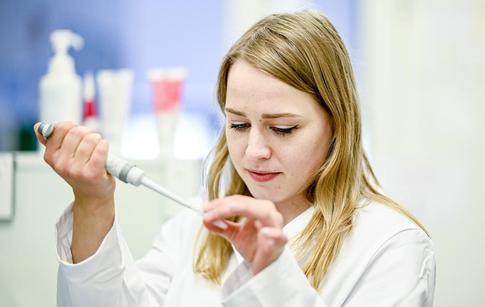XFEL: Shining the light on candidates for COVID drugs
Shining the light on candidates for COVID drugs

Christina Schmidt, one of the co-authors on the publication and Research Assistant at European XFEL's Sample Environment and Characterisation team, at work on an experiment. Copyright: European XFEL.
The team, led by DESY physicist Alke Meents, screened drugs that bind to an important protein of the SARS-CoV-2 virus and could therefore be the basis for a drug against Covid-19. After measuring about 7000 samples, the team was able to identify a total of 37 substances that bind to the main protease (Mpro) of the SARS-CoV-2 virus. The team at the European XFEL supported the screening process remotely and did follow up experiments to verify the outcome. Seven of these substances inhibit the activity of the protein and thus slow down the multiplication of the virus. Two of them do this so promisingly that they are currently under further investigation in preclinical studies. This drug screening – probably the largest of its kind – also revealed something unexpected: a binding site on the main protease that was hitherto completely unknown.
“Having drugs that effectively combat the coronavirus SARS-CoV-2, in addition to effective vaccines, will give the medical community an opportunity to use a multi-pronged approach to beat the COVID-19 pandemic,” says Kristina Lorenzen, manager of the biolabs at European XFEL, and one of the authors of the publication. In contrast to vaccines, which help healthy people to defend themselves against the virus, drug research is looking for drugs that slow down or stop the reproduction of the virus in the body of people who are already infected. Viruses cannot reproduce on their own. Instead, they introduce their own genetic material into the cells of their host and make them produce new viruses. Proteins such as the main protease of the virus play an important role in this process. Protease cuts protein chains produced by the host cell according to the blueprint of the virus genetic material into smaller parts that are necessary for the reproduction of the virus. If the main protease can be blocked, the cycle can possibly be interrupted; the virus can no longer reproduce and the infection is defeated.
Beamline P11 of DESY´s PETRA III research lightsource specialises in structural biology studies. The team used this capability to examine the several thousand active substances from a library of the Fraunhofer Institute for Translational Medicine and Pharmacology and another library from the Italian company Dompé Farmaceutici SpA. Researchers were looking for how the drug candidates “dock” to the main protease – the first important step in blocking it. Like a key in a lock, the drug molecule fits into a binding centre of the protease. The advantage of screening the substances from drug library is that they have already been approved for treatment of humans or are currently in various testing phases. Suitable candidates to combat SARS-CoV-2 could therefore be used in clinical trials considerably faster, saving months or years of drug development.
In a next step, the researchers at the Bernhard Nocht Institute for Tropical Medicine investigated whether these active substances inhibit or even prevent virus replication in cell cultures and how compatible they are for the host cells. This reduced the number of suitable active substances to seven, two of which stood out in particular. “The active substances Calpeptin and Pelitinib clearly showed the highest antivirality with good cell compatibility. Our cooperation partners have therefore already started preclinical investigations with these two substances,” explains DESY researcher Sebastian Günther, first author of the publication.
“Studies like this underpin the importance of lightsources, such as synchrotrons and FELs, in novel approaches to beat the COVID-19 pandemic. Here at European XFEL, our first beamtime for 2021 is dedicated to experiments looking at getting deeper insights into the SARS-CoV-2 virus, and I look forward to learning about the results of these experiments” says European XFEL Managing Director Robert Feidenhans'l.
More information: DESY X-ray lightsource identifies promising candidates for COVID drugs
